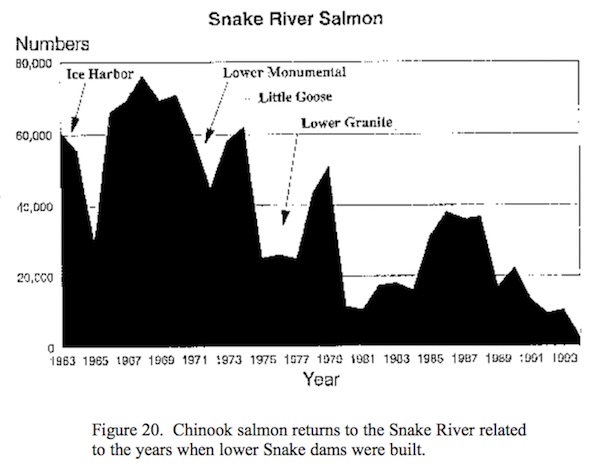forum
library
tutorial
contact

Rivers, Hydropower and
Climate Resilience
by Tom Kiernan
The Hill, May 25, 2021
|
the film forum library tutorial contact |

|
Rivers, Hydropower and
by Tom Kiernan
|
Scientists say that any plan to recover salmon must include the removal of the
four dams on the lower Snake, to improve river conditions and access to habitat.
 The impacts of climate change, felt first and hardest on the water cycle in the form of floods and droughts, demand that we protect and restore healthy, free-flowing rivers. In addition to protecting rivers that provide our drinking water, irrigate crops, manage floodwaters, recharge groundwater supplies and nurture fish and wildlife, we must reduce reliance on fossil fuels and boost energy from renewable sources.
The impacts of climate change, felt first and hardest on the water cycle in the form of floods and droughts, demand that we protect and restore healthy, free-flowing rivers. In addition to protecting rivers that provide our drinking water, irrigate crops, manage floodwaters, recharge groundwater supplies and nurture fish and wildlife, we must reduce reliance on fossil fuels and boost energy from renewable sources.
Given the need to reduce emissions and protect healthy rivers, what role should hydropower play?
Hydropower dams will continue to play a significant role in our nation's energy portfolio. At American Rivers, we recognize this. But we cannot responsibly meet our nation's 21st century energy needs by building new dams that damage more rivers, by weakening environmental protections designed to protect rivers from harmful dam operations, or by supporting hydropower that perpetuates injustice.
In the Pacific Northwest, a decades-long debate around the role and impacts of hydropower on the environment and Native American tribes has been heating up literally and figuratively. In the Columbia River basin, four dams on the lower Snake River are pushing salmon to extinction. Hydropower produced by the four lower Snake dams cannot be considered "green" or "clean" given the cumulative, staggering impacts of these dams on the ecosystem and salmon runs. Salmon are essential to the cultures, identities and economies of tribes across the region, and the loss of salmon is an ongoing and devastating injustice.
Scientists say that any plan to recover salmon must include the removal of the four dams on the lower Snake, to improve river conditions and access to habitat. Climate change is making the need for Snake River restoration urgent: The slackwater pools behind the dams are heating up, creating lethal conditions for fish. High water temperatures in 2015 killed over 90 percent of returning Snake River sockeye before they could make it upstream to spawn in Idaho. The Environmental Protection Agency (EPA) forecasts that removing the four lower Snake dams would reduce water temperatures to levels that are safer for endangered salmon, even in very hot years.
The Bonneville Power Administration and other agencies that operate the federal hydropower dams on the Columbia and Snake rivers have spent $17 billion over 40 years on salmon recovery to avoid the need for dam removal. These investments have been necessary but not sufficient nor successful. A recent analysis by the Nez Perce Tribe found that many Snake River salmon populations are entering an "extinction vortex" with nearly half of the wild spring chinook populations in the Snake River Basin nearing a dire extinction threshold and without intervention may not persist.
We need to use visionary thinking to resolve long standing impacts of the lower Snake River dams on salmon as part of a climate wise strategy. The power produced by these dams can be replaced with clean, reliable and affordable alternatives that will create jobs while also helping confront the global climate crisis. Beyond replacing the power we should invest in modernizing the region's power grid, improved battery storage, energy efficiency and demand management.
Leaders from the 12 Columbia Basin tribes, led by the Nez Perce, have called for a collaborative legislative solution. U.S. Reps. Earl Blumenauer (D-Ore.) and Mike Simpson (R-Idaho), members of Congress on opposite sides of the political spectrum, are encouraging the region to support a federal legislative package that includes breaching the four lower Snake River dams and investing to replace their services to agriculture and power generation. Sen. Patty Murray (D-Wash.) recently released a statement with Washington Gov. Jay Inslee (D), calling for "action and a resolution that restores salmon runs and works for all the stakeholders and communities in the Columbia River Basin."
The time for action is now. The infrastructure package that Congress is developing with the Biden administration is the perfect opportunity to prioritize immediate investments on an aggressive timeline that will reduce environmental harms and cultural injustices, and provide climate resilience, all while providing much needed jobs and economic stimulus for the region.
learn more on topics covered in the film
see the video
read the script
learn the songs
discussion forum
